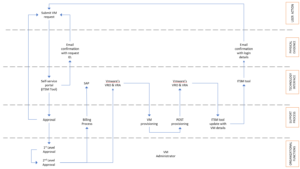Virtual Machine (VM) provision using Service Automation Framework®
Once simply a cost centre, IT is now recognised as a key strategic asset for the modern enterprise. More than ever before, CEOs are looking to the IT organisation to deliver tangible business value that contributes to the bottom line. As a result, the priorities for today’s CIO are quite different than in the past:

Virtual Machine (VM) provision using Service Automation Framework®
- Innovation: Refocus IT resources on strategic initiatives that drive business growth and generate new revenue streams.
- Value creation: Improve effectiveness through agile, reliable services that meet the critical needs of the business.
- Differentiation: Create unique, compelling services that offer competitive advantage and build brand value.
Staying ahead of the competition and growing the business require the ability to respond quickly and flexibly to changes in the marketplace. To give them the tools they need to accomplish these objectives, business users are demanding ever-faster service deployment.
Today’s IT organisations are under increasing pressure to deploy private or hybrid clouds and become a service provider to their business users. Gone are the days when users were willing to wait patiently for weeks or months for IT to order, install, configure, and deliver the resources required to host a new business application or a testing and development platform.
Expectations have been heightened skyward by delivery models such Amazon’s EC2, Microsoft Azure and other cloud providers—you simply swipe a credit card and within minutes can begin building applications on a fully provisioned stack. Users want this kind of responsiveness for their business applications and are more than happy to do their own provisioning—if IT will just give them the right tools.
Automatic provisioning and deployment of customer-requested infrastructure offers a solution. A fully automated system can in principle reduce the infrastructure provisioning time from weeks to days, providing significant benefits to the IT organization as well as business users. However, realising the full benefits of automated provisioning requires addressing the complete end-to-end workflow, from business request to service activation, which involves technology, people, and processes.
The requirement for automating VMware’s virtual machine provisioning was a project Pink Elephant and our consultants were involved for an Oil and Gas organisation in Malaysia.
Service Automation Framework® was used as the best practice framework to develop automation blueprint which assists in the development and deployment of end-to-end virtual machine provisioning solution. Following the framework:
Service Automation Gap Assessment: Assessment was done using Pink Elephant’s ITSM Maturity assessment and benchmarking tool, ‘Pink SCAN’. This baseline is the point from which future improvements and progress can be measured. The outcome of this step is to determines the state of the service catalogue, service portals, service level agreements, technology and skills requirements based on the Service Automation Framework.
Service Automation – Gap Analysis Document: Documenting few of the the ‘as-is’ state and pain points, which in the project we undertook were documented as below:
- Inconsistency in data entry, errors and miskeying information in provisioning
- Large ongoing staff training cost
- Time consuming in deployment (average of 6 weeks)
- Time delay to produce reports on provisioning (1 week)
- Duplication of data entry, duplication of provisioning
Service Automation Blueprinting: For every virtual machine related service in the service catalogue, Pink Elephant’s consultants composed service automation blue print. The blue print outlines the workflows / communication and scripts that need to be assembled in the Self Service Portal. Blue printing is an essential technique that is used in service automation and provides key information that is necessary for scripting and process automation. Blueprinting VM provisioning service is as below.

Self Service Portal Design: The self-service portal is the user’s gateway to services. Users simply browse the online service catalog, where they can drill down from the list of catalogues to look at the details of each offering and then select and option up the services they want to deploy. Once the appropriate approvals are obtained, the actual provisioning takes place automatically with no ‘touching” from IT staff. Look and feel and ease of use are critical for successful adoption by users of the portal. The service catalog built within the self-service portal is the key to automated provisioning and deployment.
The service catalog defines in detail all services—public and private—that are available to business users. It must be kept scrupulously up to date and synchronized with VMware’s VRO and VRA’s catalogue. Few of the virtual machine services documented in service catalogue were:
- Virtual Machine Provisioning
- Virtual Machine Configuration
- Virtual Machine Interaction
- Virtual Machine Inventory
- Virtual Machine State
Client Approval and Launch: Upon completion of designed and implementing the automated services according to the service automation blueprint, we launched the portal and value realisation was documented.
- Inconsistency in data entry, errors and miskeying information in provisioning – Reduced by >80%
- Large ongoing staff training cost – Reduced by 50% in 1st month alone and previously manual deploying staffs were redeployed to other projects
- Time consuming in deployment (average of 6 weeks) – Reduced to <48 hours
- Time delay to produce reports on provisioning (1 week) – Reduced to <48 hours
- Duplication of data entry, duplication of provisioning – Reduced to 0 duplication
